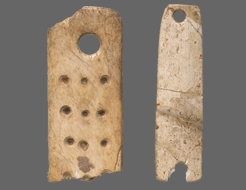|
||||||||||||||||||||||||||||||||
|
|
Museum of: Rome | |||||||||||||||||||||||||||||||
| Name of the artefact: Bone pendant with circular indentations | ||||||||||||||||||||||||||||||||
|
This pendant, carved out in bone with several lines of
holes, was collected in a grave of a male. The man buried with this
pendant was probably a ‘big man’ who received a special treatment during
his life (the cranium drilling) and death (a wealth burial of several
vessels, stone and bone implements, shells and so on). These things were
probably the personal mark of distinction of their proud owner, surely the
chief of a large middle neolithic community living around the cave.
|
||||||||||||||||||||||||||||||||
|
WHERE IS IT AND MAIN
CHARACTERISTICS |
STATE |
|||||||||||||||||||||||||||||||
|
Department: |
- |
Preservation: |
Good | |||||||||||||||||||||||||||||
|
Inventory number: |
103254b |
Restauration: |
No restored | |||||||||||||||||||||||||||||
|
Name of the artefact: |
Bone pendant with circular
indentations |
Completeness: |
Incomplete | |||||||||||||||||||||||||||||
|
Object type: |
Jwellery |
|||||||||||||||||||||||||||||||
|
Material: |
Bone (sheep metacarpus) |
|||||||||||||||||||||||||||||||
|
Methof of manufacture: |
Polishing, incision |
|||||||||||||||||||||||||||||||
|
Decoration
type: |
Incision |
|||||||||||||||||||||||||||||||
|
Distinctive mark: |
- |
|||||||||||||||||||||||||||||||
|
DIMENSIONS |
PERIOD OF USE |
|||||||||||||||||||||||||||||||
|
Length (mm): |
- |
Epoque: |
Neolithic |
|||||||||||||||||||||||||||||
|
Heigth
(mm): |
- |
Culture: |
Linear Ware |
|||||||||||||||||||||||||||||
|
Diameter
(mm): |
- |
Period: |
Middle Neolithic |
|||||||||||||||||||||||||||||
|
Width (mm): |
- |
Face: |
- |
|||||||||||||||||||||||||||||
|
Thickness (mm): |
- |
Absolute chronology: |
6300-5900 BP |
|||||||||||||||||||||||||||||
|
Weight
(g): |
- |
|||||||||||||||||||||||||||||||
DISCOVERY |
||||||||||||||||||||||||||||||||
|
Date: |
1949-59 |
Country: |
Italy |
|||||||||||||||||||||||||||||
|
District: |
Lazio |
Town hall affiliation: |
Roma |
|||||||||||||||||||||||||||||
|
Village: |
Cerveteri |
Discovery findspot: |
Grotta Patrizi, Sasso di Furbara
, |
|||||||||||||||||||||||||||||
|
Condition of discovery: |
Archaeological excavation |
Discovery type: |
Deposit |
|||||||||||||||||||||||||||||
|
ANALYSES – DETERMINATIONS |
FILLED IN BY |
|||||||||||||||||||||||||||||||
|
Type: |
- |
Name: |
Chiara Delpino, Vincenzo Tinè |
|||||||||||||||||||||||||||||
|
Laboratory: |
- |
Institution: |
- |
|||||||||||||||||||||||||||||
|
No./Code: |
- |
Date: |
10-2005 |
|||||||||||||||||||||||||||||
|
DEEPENINGS |
||||||||||||||||||||||||||||||||
|
Morphology of the object: |
||||||||||||||||||||||||||||||||
|
Rectangular fragment of a small plate made out of bone.
On the surface it presents three lines of round indentations and the
remains of another row. The surviving extremitiy is perforated. The plate
is decorated on the smooth side while the other side has a sponge
texture. |
||||||||||||||||||||||||||||||||
|
Decoration: |
||||||||||||||||||||||||||||||||
|
- |
||||||||||||||||||||||||||||||||
|
Inscription: |
||||||||||||||||||||||||||||||||
|
- |
||||||||||||||||||||||||||||||||
|
Analogies: |
||||||||||||||||||||||||||||||||
|
Another rectangular bone plate was recovered among the
funerary objects. A hole is present on each of the extremities and the
whole surface, as well as the sides, are polished(in exhibit at the
Pigorini Museum, archive n. 103254a. The funerary ritual used in the
burial in Grotta dei Patrizi bears analogies with the ones in Grotta
dell’Orso, in Tuscany. In both cases we witnessed the appearance, in
contrast to the Early Neolithic Period, of new rituals characterized by:
ornamental items, vessels, shells and peculiar objects. There is a
continuity in the use of ochre, in the frequent use of cinnabar, the
innovative presence of stone circles and an increase of graining
stones(with a clear symbolic relevance)positioned in the burials. In
contraposition with the common practice, during the Early Neolithic
Period, of laying the bodies on their left side, burials in the Grotta dei
Patrizi were randomly positioned on their left, right side as well as
seated. A new element is also the trepanation of the skull, a surgical
practice that can be interpreted in a therapeutic function also in
rituals. |
||||||||||||||||||||||||||||||||
|
Interpretation: |
||||||||||||||||||||||||||||||||
|
The pendant was recovered among the funerary objects of
a male burial within the Grotta Patrizi. This cave, made out of different
levels of galleries, with different rooms full of stalactites and
stalagmites, was used in the Neolithic Period as a burial site: within the
different chambers there were at least eight burials. The pendant’s owner
probably held an important social status within the community and was
buried with a peculiar ritual. First of all his funerary structure was
elevated to a monumental status by placing a layer of stones to isolate
and protect the body. Around the burial were located stone circles on the
inside of which were various shaped vessels, some of which decorated and
of fine craftsmanship as well as some grinding stones. The man had also
suffered twice the trepanation of the skull. Surgery was undertaken while
the man was still alive, he survived the operation which was subsequently
repeated. The trepanation may have been carried out to give relief or end
a pathology on a man who was not sane, as attested by the physical
anomalies present on the skull, the masticatory and muscular apparatus. It
is interesting to underline how ethnographic comparisons attest that among
some of the current “primitive populations” the shaman is usually a person
with physical or psychological anomalies. Two other neolithic examples of
bodies on which the trepanation surgery was carried out have been
recovered in Catignano (Tuscany) and Trasano (Basilicata). Even though it
is impossible to determine the social role of the buried man found in the
Grotta Patrizi it is certain that he held a prestigious position that
earned him a special treatment and special funerary ritual compared to the
other burials in the cave. |
||||||||||||||||||||||||||||||||
|
Bibliography: |
||||||||||||||||||||||||||||||||
|
BAGOLINI B., GRIFONI CREMONESI R., 1987, Il Neolitico
italiano: facies culturali e manifestazioni funerarie, Bullettino di
Paletnologia italiana, 85, n.s., III, pp.139-170 FAVATI VANNI V., 1962,
Resti ossei umani di Grotta Patrizi (Sasso di Furbara), Archeologi,a
Antropologia, Etnologia, XCII, pp.403-410 GERMANÀ F., FRONACIARI R., 1992,
Trapanazione, craniotomie e traumi cranici in Italia dalla preistoria
all’età moderna, Pisa GRIFONI CREMONESI R., 1967, La grotta dell’Orso di
Sarteano, Origini, I, pp.53-115 GUILANE J., CREMONESI G., 1987, L’habitat
néolithique de Trasano (Matera- Basilicata). Prémiers résultats, Atti XXVI
Riunione scientifica istituto Italiano di Preistoria e Protostoria,
Firenze, pp.707-720. PATRIZI S., RADMILLI A.M., MANGILI G., 1954,
Sepoltura ad inumazione con cranio trapanato nella grotta Patrizi al Sasso
di Furbara, Rivista di Antropologia, XLI, pp.33-68 |
||||||||||||||||||||||||||||||||

